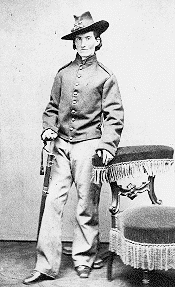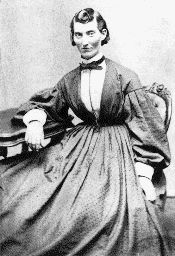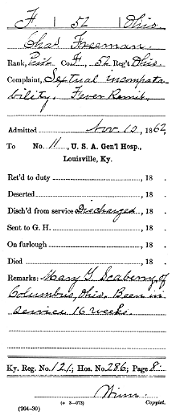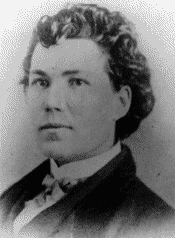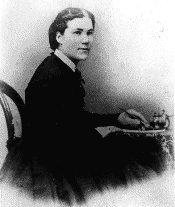
Women Soldiers of the Civil War
Spring 1993, Vol. 25, No. 1
By DeAnne Blanton
© 1993 by DeAnne Blanton
It is an accepted convention that the Civil War was a man's fight. Images of women during that conflict center on self-sacrificing nurses, romantic spies, or brave ladies maintaining the home front in the absence of their men. The men, of course, marched off to war, lived in germ-ridden camps, engaged in heinous battle, languished in appalling prison camps, and died horribly, yet heroically. This conventional picture of gender roles during the Civil War does not tell the entire story. Men were not the only ones to fight that war. Women bore arms and charged into battle, too. Like the men, there were women who lived in camp, suffered in prisons, and died for their respective causes.
Both the Union and Confederate armies forbade the enlistment of women. Women soldiers of the Civil War therefore assumed masculine names, disguised themselves as men, and hid the fact they were female. Because they passed as men, it is impossible to know with any certainty how many women soldiers served in the Civil War. Estimates place as many as 250 women in the ranks of the Confederate army.(1) Writing in 1888, Mary Livermore of the U.S. Sanitary Commission remembered that:
Some one has stated the number of women soldiers known to the service as little less than four hundred. I cannot vouch for the correctness of this estimate, but I am convinced that a larger number of women disguised themselves and enlisted in the service, for one cause or other, than was dreamed of. Entrenched in secrecy, and regarded as men, they were sometimes revealed as women, by accident or casualty. Some startling histories of these military women were current in the gossip of army life.(2)
Livermore and the soldiers in the Union army were not the only ones who knew of soldier-women. Ordinary citizens heard of them, too. Mary Owens, discovered to be a woman after she was wounded in the arm, returned to her Pennsylvania home to a warm reception and press coverage. She had served for eighteen months under the alias John Evans.(3)
In the post - Civil War era, the topic of women soldiers continued to arise in both literature and the press. Frank Moore's Women of the War, published in 1866, devoted an entire chapter to the military heroines of the North. A year later, L. P. Brockett and Mary Vaughan mentioned ladies "who from whatever cause . . . donned the male attire and concealed their sex . . . [who] did not seek to be known as women, but preferred to pass for men."(4) Loreta Velazquez published her memoirs in 1876. She served the Confederacy as Lt. Harry Buford, a self-financed soldier not officially attached to any regiment.
The existence of soldier-women was no secret during or after the Civil War. The reading public, at least, was well aware that these women rejected Victorian social constraints confining them to the domestic sphere. Their motives were open to speculation, perhaps, but not their actions, as numerous newspaper stories and obituaries of women soldiers testified.
Most of the articles provided few specific details about the individual woman's army career. For example, the obituary of Satronia Smith Hunt merely stated she enlisted in an Iowa regiment with her first husband. He died of battle wounds, but she apparently emerged from the war unscathed.(5) An 1896 story about Mary Stevens Jenkins, who died in 1881, tells an equally brief tale. She enlisted in a Pennsylvania regiment when still a schoolgirl, remained in the army two years, received several wounds, and was discharged without anyone ever realizing she was female.(6) The press seemed unconcerned about the women's actual military exploits. Rather, the fascination lay in the simple fact that they had been in the army.
The army itself, however, held no regard for women soldiers, Union or Confederate. Indeed, despite recorded evidence to the contrary, the U.S. Army tried to deny that women played a military role, however small, in the Civil War. On October 21, 1909, Ida Tarbell of The American Magazine wrote to Gen. F. C. Ainsworth, the adjutant general: "I am anxious to know whether your department has any record of the number of women who enlisted and served in the Civil War, or has it any record of any women who were in the service?" She received swift reply from the Records and Pension Office, a division of the Adjutant General's Office (AGO), under Ainsworth's signature. The response read in part:
I have the honor to inform you that no official record has been found in the War Department showing specifically that any woman was ever enlisted in the military service of the United States as a member of any organization of the Regular or Volunteer Army at any time during the period of the civil war. It is possible, however, that there may have been a few instances of women having served as soldiers for a short time without their sex having been detected, but no record of such cases is known to exist in the official files.(7)
This response to Ms. Tarbell's request is untrue. One of the duties of the AGO was maintenance of the U.S. Army's archives, and the AGO took good care of the extant records created during that conflict. By 1909 the AGO had also created compiled military service records (CMSR) for the participants of the Civil War, both Union and Confederate, through painstaking copying of names and remarks from official federal documents and captured Confederate records. Two such CMSRs prove the point that the army did have documentation of the service of women soldiers.
The Union CMSR for John Williams of the Seventeenth Missouri Infantry, Company H, shows that the nineteen-year-old soldier enlisted as a private on October 3, 1861, in St. Louis and was mustered into the regiment on the seventh. Later that month, Williams was discharged on the grounds: "proved to be a woman."(8) The Confederate CMSR for Mrs. S. M. Blaylock, Twenty-sixth North Carolina Infantry, Company F, states:
This lady dressed in men's clothes, Volunteered [sic], received bounty and for two weeks did all the duties of a soldier before she was found out, but her husband being discharged, she disclosed the fact, returned the bounty, and was immediately discharged April 20, 1862.(9)
Another woman documented in the records held by the AGO was Mary Scaberry, alias Charles Freeman, Fifty-second Ohio Infantry. Scaberry enlisted as a private in the summer of 1862 at the age of seventeen. On November 7 she was admitted to the General Hospital in Lebanon, Kentucky, suffering from a serious fever. She was transferred to a hospital in Louisville, and on the tenth, hospital personnel discovered "sexual incompatibility [sic]." In other words, the feverish soldier was female. Like John Williams, Scaberry was discharged from Union service.(10)
Not all of the women soldiers of the Civil War were discharged so quickly. Some women served for years, like Sarah Emma Edmonds Seelye, and others served the entire war, like Albert D. J. Cashier. These two women are the best known and most fully documented of all the women combatants.
Records from the AGO show that Sarah Edmonds, a Canadian by birth, assumed the alias of Franklin Thompson and enlisted as a private in the Second Michigan Infantry in Detroit on May 25, 1861. Her duties while in the Union army included regimental nurse and mail and despatch carrier. Her regiment participated in the Peninsula campaign and the battles of First Manassas, Fredericksburg, and Antietam. On April 19, 1863, Edmonds deserted because she acquired malaria, and she feared that hospitalization would reveal her gender. In 1867 she married L. H. Seelye, a Canadian mechanic. They raised three children. In 1886 she received a government pension based upon her military service. A letter from the secretary of war, dated June 30 of that year, acknowledged her as "a female soldier who . . . served as a private . . . rendering faithful service in the ranks." Sarah Edmonds Seelye died September 5, 1898, in Texas.(11)
AGO records also reveal that on August 3, 1862, a nineteen-year-old Irish immigrant named Albert D. J. Cashier, described as having a light complexion, blue eyes, and auburn hair, enlisted in the Ninety-fifth Illinois Infantry. Cashier served steadily until August 17, 1865, when the regiment was mustered out of the Federal army. Cashier participated in approximately forty battles and skirmishes in those long, hard four years.
After the war, Cashier worked as a laborer, eventually drew a pension, and finally went to live in the Quincy, Illinois, Soldiers' Home. In 1913 a surgeon at the home discovered that Albert D. J. Cashier was a woman. A public disclosure of the finding touched off a storm of sensational newspaper stories, for Cashier had lived her entire adult life as a man. None of Cashier's former comrades-in-arms ever suspected that he was a she. Apparently, neither did the commandant at the Soldiers' Home. She died October 11, 1914, in an insane asylum.(12) [A deposition from a fellow soldier taken in 1915 revealed that her deception was quite complete.]
Despite the fact that the U.S. Army did not acknowledge or advertise their existence, it is surprising that the women soldiers of the Civil War are not better known today. After all, their existence was known at the time and through the rest of the nineteenth century. Even though some modern writers have considered Seelye and Cashier, the majority of historians who have written about the common soldiers of the war have either ignored women in the ranks or trivialized their experience. While references, usually in passing, are sometimes found, the assumption by many respected Civil War historians is that soldier-women were eccentric and their presence isolated. Textbooks hardly ever mention these women.
The writings of Bell Wiley and Mary Massey are good examples. Wiley wrote at some length of "the gentler sex who disguised themselves and swapped brooms for muskets [who] were able to sustain the deception for amazingly long periods of time." But he later refers to them, indirectly, as "freaks and distinct types."(13) Massey erroneously asserted that "probably most of the women soldiers were prostitutes or concubines."(14) For the most part, modern researchers looking for evidence of soldier-women must rely heavily upon Civil War diaries and late nineteenth-century memoirs.
It is true that the military service of women did not affect the outcome of campaigns or battles. Their service did not alter the course of the war. Compared with the number of men who fought, the women are statistically irrelevant. But the women are significant because they were there and they were not supposed to be. The late nineteenth-century newspaper writers grasped this point. The actions of Civil War soldier-women flew in the face of mid-nineteenth-century society's characterization of women as frail, subordinate, passive, and not interested in the public realm.
Simply because the woman soldier does not fit the traditional female image, she should not be excluded from, or misinterpreted in, current and future historical writings. While this essay cannot discuss all the soldier-women, their lives and military records, recent chroniclers of the Civil War and women's history have begun to note the gallantry of women in the ranks during the war.(15) Most important, recent works refrain from stereotyping the women soldiers as prostitutes, mentally ill, homosexual, social misfits, or anything other than what they were: soldiers fighting for their respective governments of their own volition.
It is perhaps hard to imagine how the women soldiers maintained their necessary deception or even how they successfully managed to enlist. It was probably very easy. In assuming the male disguise, women soldiers picked male names. Army recruiters, both Northern and Southern, did not ask for proof of identity. Soldier-women bound their breasts when necessary, padded the waists of their trousers, and cut their hair short. Loreta Velazquez wore a false mustache, developed a masculine gait, learned to smoke cigars, and padded her uniform coat to make herself look more muscular.
While recruits on both sides of the conflict were theoretically subject to physical examinations, those exams were usually farcical. Most recruiters only looked for visible handicaps, such as deafness, poor eyesight, or lameness. Neither army standardized the medical exams, and those charged with performing them hardly ever ordered recruits to strip. That roughly 750 women enlisted attests to the lax and perfunctory nature of recruitment physical checks.
Once in the ranks, successful soldier-women probably learned to act and talk like men. With their uniforms loose and ill-fitting and with so many underage boys in the ranks, women, especially due to their lack of facial hair, could pass as young men. Also, Victorian men, by and large, were modest by today's standards. Soldiers slept in their clothes, bathed in their underwear, and went as long as six weeks without changing their underclothes. Many refused to use the odorous and disgusting long, open-trenched latrines of camp. Thus, a woman soldier would not call undue attention to herself if she acted modestly, trekked to the woods to answer the call of nature and attend to other personal matters, or left camp before dawn to privately bathe in a nearby stream.(16)
Militarily, the women soldiers faced few disadvantages. The vast majority of the common soldiers during the Civil War were former civilians who volunteered for service. These amateur citizen soldiers enlisted ignorant of army life. Many privates had never fired a gun before entering the army. The women soldiers learned to be warriors just like the men.
The women soldiers easily concealed their gender in order to fulfill their desire to fight. An unknown number of them, like Cashier, Jenkins, and Hunt, were never revealed as women during their army stint. Of those who were, very few were discovered for acting unsoldierly or stereotypically feminine. Though Sarah Collins of Wisconsin was suspected of being female by the way she put on her shoes, she was atypical.(17)
Also unusual were the Union women under Gen. Philip Sheridan's command, one a teamster and the other a private in a cavalry regiment, who got drunk and fell into a river. The soldiers who rescued the pair made the gender discoveries in the process of resuscitating them. Sheridan personally interviewed the two and later described the woman teamster as coarse and the "she-dragoon" as rather prepossessing, even with her unfeminine suntan.(18) He did not state their real names, aliases, or regiments.
For the most part, women were recognized after they had received serious wounds or died. Mary Galloway was wounded in the chest during the Battle of Antietam. Clara Barton, attending to the wound, discovered the gender of the soft-faced "boy" and coaxed her into revealing her true identity and going home after recuperation.(19) One anonymous woman wearing the uniform of a Confederate private was found dead on the Gettysburg battlefield on July 17, 1863, by a burial detail from the Union II Corps.(20) Based on the location of the body, it is likely the Southern woman died participating in Pickett's charge. In 1934, a gravesight found on the outskirts of Shiloh National Military Park revealed the bones of nine Union soldiers. Further investigation indicated that one of the skeletons, with a minieball by the remains, was female.(21) The identities of these two dead women are lost to posterity.
Some soldiers were revealed as women after getting captured. Frances Hook is a good example. She and her brother, orphans, enlisted together early in the war. She was twenty-two years old, of medium build, with hazel eyes and dark brown hair. Even though her brother was killed in action at Pittsburgh Landing, Hook continued service, probably in an Illinois infantry regiment, under the alias Frank Miller. In early 1864, Confederates captured her near Florence, Alabama; she was shot in the thigh during a battle and left behind with other wounded, who were also captured. While imprisoned in Atlanta, her captors realized her gender. After her exchange at Graysville, Georgia, on February 17, 1864, she was cared for in Union hospitals in Tennessee, then discharged and sent North in June. Having no one to return to, she may have reenlisted in another guise and served the rest of the war. Frances Hook later married, and on March 17, 1908, her daughter wrote the AGO seeking confirmation of her mother's military service. AGO clerks searched pertinent records and located documentation.(22)
Other prisoners of war included Madame Collier and Florina Budwin. Collier was a federal soldier from East Tennessee who enjoyed army life until her capture and subsequent imprisonment at Belle Isle, Virginia. She decided to make the most of the difficult situation and continued concealing her gender, hoping for exchange. Another prisoner learned her secret and reported it to Confederate authorities, who sent her North under a flag of truce. Before leaving, Collier indicated that another woman remained incarcerated on the island.(23)
Florina Budwin and her husband enlisted together, served side by side in battle, were captured at the same time by Confederates, and both sent to the infamous Andersonville prison. (The date of their incarceration has not been determined.) Mr. Budwin died there in the stockade, but Mrs. Budwin survived until after her transfer with other prisoners in late 1864 to a prison in Florence, South Carolina. There she was stricken by an unspecified epidemic, and a Southern doctor discovered her identity. Despite immediately receiving better treatment, she died January 25, 1865.(24)
The women soldiers of the Civil War engaged in combat, were wounded and taken prisoner, and were killed in action. They went to war strictly by choice, knowing the risks involved. Their reasons for doing so varied greatly. Some, like Budwin and Hook, wished to be by the sides of their loved ones. Perhaps others viewed war as excitement and travel. Working class and poor women were probably enticed by the bounties and the promise of a regular paycheck. And of course, patriotism was a primary motive. Sarah Edmonds wrote in 1865, "I could only thank God that I was free and could go forward and work, and I was not obliged to stay at home and weep."(25) Obviously, other soldier-women did not wish to stay at home weeping, either.
Herein lies the importance of the women combatants of the Civil War: it is not their individual exploits but the fact that they fought. While their service could not significantly alter the course of the war, women soldiers deserve remembrance because their actions display them as uncommon and revolutionary, with a valor at odds with Victorian views of women's proper role. Quite simply, the women in the ranks, both Union and Confederate, refused to stay in their socially mandated place, even if it meant resorting to subterfuge to achieve their goal of being soldiers. They faced not only the guns of the adversary but also the sexual prejudices of their society.
The women soldiers of the Civil War merit recognition in modern American society because they were trailblazers. Women's service in the military is socially accepted today, yet modern women soldiers are still officially barred from direct combat. Since the Persian Gulf war, debate has raged over whether women are fit for combat, and the issue is still unresolved. The women soldiers of the Civil War were capable fighters. From a historical viewpoint, the women combatants of 1861 to 1865 were not just ahead of their time; they were ahead of our time.
DeAnne Blanton is an archivist in the National Archives and Records Administration's Old Military and Civil Branch. She received her M.A. in American history from Wake Forest University.
Notes
1. Lauren Burgess, "'Typical' Soldier May Have Been Red-Blooded American Woman," The Washington Times, Oct. 5, 1991.
2. Mary A. Livermore, My Story of the War (1888), pp. 119-120.
3. "Women Soldiering as Men," New York Sun, Feb. 10, 1901.
4. L. P. Brockett and Mary Vaughan, Women's Work in the Civil War (1867), p. 770.
5. Obituary of Satronia Smith Hunt, unidentified newspaper clipping, envelope re women soldiers, Old Records Division reference file, Records of the Adjutant General's Office, Record Group 94, National Archives and Records Administration, Washington, DC (hereinafter cited as RG 94, NA).
6. "Served by her Lover's Side," The Evening Star (Washington, DC), July 7, 1896.
7. Documents numbered 158003, Records and Pension Office file 184934, RG 94, NA.
8. Compiled military service record (CMSR) of John Williams, Seventeenth Missouri Infantry, RG 94, NA.
9. CMSR for Mrs. S.M. Blaylock, Twenty-sixth North Carolina Infantry, War Department Collection of Confederate Records, RG 109, NA.
10. Carded medical records for Charles Freeman, 52d Ohio Infantry, Mexican and Civil Wars, RG 94, NA.
11. CMSR for Franklin Thompson, Second Michigan Infantry; and Enlisted Branch file 3132 C 1884, both in RG 94, NA.
12. CMSR for Albert D.J. Cashier, Ninety-fifth Illinois Infantry, RG 94, NA; and pension application case file C 2573248, Records of the Veterans Administration, RG 15, NA.
13. Bell Irvin Wiley, The Life of Billy Yank: The Common Soldier of the Union (1951), pp. 337, 339.
14. Mary Elizabeth Massey, Bonnet Brigades (1966), p. 84.
15. In the last ten years, articles about Civil War women soldiers have appeared in such diverse publications as Minerva: Quarterly Report on Women and the Military, Southern Studies, and The Civil War Book Exchange and Collector. For a discussion of a Revolutionary War woman soldier, see Julia Ward Stickley, "The Records of Deborah Sampson Gannett, Woman Soldier of the Revolution," Prologue 4 (1972): 233–241.
16. George Worthington Adams, Doctors in Blue: The Medical History of the Union Army in the Civil War (1952), pp. 12–13; Wendy A. King, Clad in Uniform: Women Soldiers of the Civil War (1992), pp. 18, 20; and Loreta Janeta Velazquez, The Woman in Battle (1876), p. 58.
17. Massey, Bonnet Brigades, p. 80.
18. Philip Henry Sheridan, Personal Memoirs (1904), 1: 254–255.
19. Elizabeth Brown Pryor, Clara Barton, Professional Angel (1987), p. 99.
20. U.S. War Department, The War of the Rebellion: A Compilation of the Official Records of the Union and Confederate Armies (1889), series 1, Vol. 27, part I, p. 378.
21. Stewart Sifakis, Who Was Who in the Civil War (1988), p. 14.
22. Document file record card 1502399, RG 94, NA; and "Women Soldiering as Men."
23. John L. Ransom, Andersonville Diary (1881), pp. 20–21.
24. Sifakis, Who Was Who, p. 86.
25. S. Emma E. Edmonds, Nurse and Spy in the Union Army (1865), pp. 20–21.
